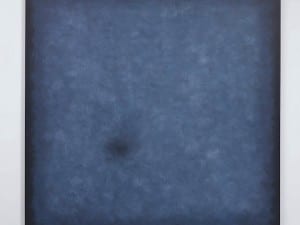Five / Fifty / Five Hundred marks the celebrations beginning of the fifth Lisson Gallery Milan anniversary. A group exhibition takes place inside one of the most ancient and gladly hidden places in Milan. Artworks included cast a wealth of well-known names such as Ai Weiwei, Angela de la Cruz, Spencer Finch, Ryan Gander, Douglas Gordon, Christian Jankowski, Shirazeh Houshiary, John Latham, Richard Long, Haroon Mirza, Julian Opie and Florian Pumhösl, installed inside and outside the ground floor space of a classically designed building, set in the ancient core of the Italian city. The venue is but a short distance from the Church of Santa Maria delle Grazie where Leonardo painted The Last Supper.
The exhibition directly faces one of the landmark locations frequented by Leonardo da Vinci, an unknown piece of history, imbued with mystery. A villa and a private garden finally brought to the attention of the world-at-large also thanks international contemporary artists’ interventions and, of course, Annette Hofmann’s – International Director of Lisson Gallery, Milan, – programme.
The Gallery’s lustrum is indissolubly tied to that captivating story that is bound to fire the imagination of all Leonardo aficionados. In the gardens, for example, researchers have excavated the plot where Leonardo’s vineyard once stood in the gardens of the Casa degli Atellani. And today, the public can finally visit the House and Vineyard getting across a one-of-a-kind museum tour, divided into seven designated areas: the courtyards of Piero Portaluppi, the Zodiac Hall, the Luini Hall, Ettore Conti’s studio, the Staircase Hall, the Garden of Earthly Delights – the novellas of Matteo Bandello and, last but not least, Leonardo’s Vineyard.
It goes without saying that Five / Fifty / Five Hundred absorbs energies and inspirational sources from all the territorial legacy around, representing a sort of a growth in front of the very first exhibition I Know About Creative Block And I Know Not To Call It By Name, which was curated by British conceptual artist Ryan Gander in September 2011.
On the wall, in the entrance, Florian Pumhösl’s Studies of Georgian letters (2013) welcome visitors without saying a word. Aside from references to early modernist art, Pumhösl’s stamp paintings display his interests in pre-Columbian textile patterns and three-dimensional architectural space. For the series on view in Milan, the artist has stamped old Georgian script on to plaster using the same printing block method, effectively reproducing letters, some obsolete, others manipulated or misprinted, from an alphabet that is unreadable to all but Georgian natives or scholars of ancient languages
As well on the wall, Spencer Finch’s Fog (Lake Wononscopomac) (2016), as a pastel on paper piece, introduces a recent series of drawings by Brooklyn-based artist Spencer Finch. Unlike his earlier work Thank you, Fog (2009), which consists of photographs taken from a static camera at one-minute intervals as fog descended over a densely wooded landscape, the work featured in the exhibition Five / Fifty / Five Hundred traces changing fog over a lake in Connecticut. Like a veil drawn across the landscape, the fog both reveals and conceals, frustrating our desire to capture an accurate image and moment in time.
One of the most attractive sculptures placed inside the gallery is a large-scale, wooden structure by Ai Weiwei, an aerial form assembled in the shape of an icosahedron, a form first illustrated by Leonardo da Vinci for the mathematician Luca Pacioli’s 1509 treaty The Divine Proportion.
In the garden, Julian Opie’s Faime walking and Imogen walking, displays double-sided animations drawn from a larger series of new LED monoliths by Opie, and features images of figures in motion. Whilst these type of screens are typically used outdoors as store signs, billboards or on public transport, Opie transforms simple signage and pictographic information to evoke real people and places. In front of Opie’s totems, set as a metal contrast, Shirazeh Houshiary’s String Quintet (2011) intrudes the courtyard with five ascending stainless steel spiralling ribbons that unravel from the ground. Each ribbon rises at a different wavelength, intertwining and weaving gently upward, calling to mind real life equivalents of trees, microscopic life forms and sine curves. The sculpture’s sinuous lines also imply a long, protracted note or sound wave, giving the work an inherently musical quality.
Five / Fifty / Five Hundred runs until 28 October. Find out more: www.lissongallery.com
Credits:
1. Five / Fifty / Five Hundred. Installation view, Lisson Gallery Milan, 2016. Photography by Jack Hems © Lisson Gallery.




